Laura Bradbury's Blog, page 5
February 2, 2017
The Vineyard Horses of Burgundy

Before tractors became the norm in Burgundy, all the vineyards were plowed and tended with the help of horses. This "old" way of doing things disappeared for a few decades and the horses were replaced by tractors. In the past five years, however, I have been thrilled to see more and more horses start to work the vineyards again around our properties in Burgundy.

One day we were driving home to Villers-la-Faye from a beautiful day in Dijon and touring the caves (not wine cellars this time but actual caves with stalactites and the whole deal) in the nearby town of Bèze. We drove past this beautiful work horse in the vineyards just outside of Gevrey-Chambertin. The girls begged us to stop.
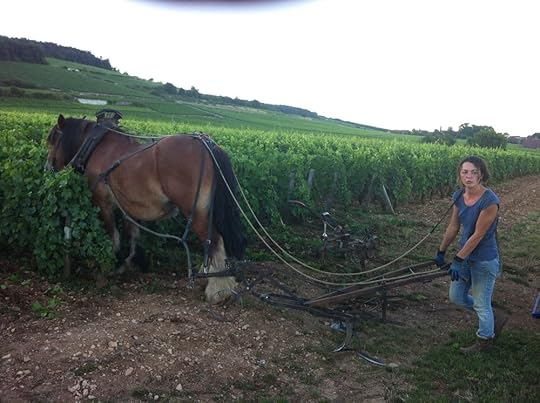
We weren't in any kind of rush (we are rarely in any kind of rush in Burgundy) so we pulled over on the side of La Nationale and hopped out. We met this lovely Burgundian woman above who trains horses to work in the vineyards and who obviously has a deep love and respect for her robust workmates. She explained all about the tools she uses and the benefits of maintaining vineyards with a horse.
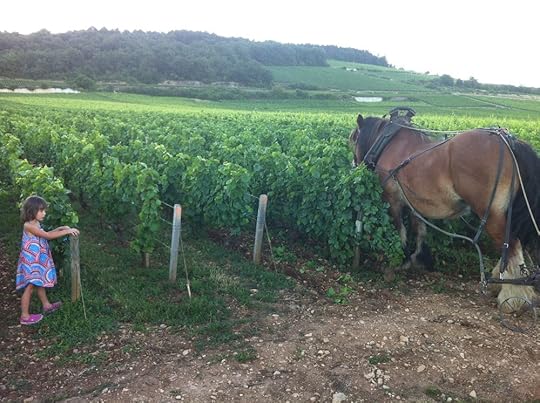
She said that using horses naturally clears out the undergrowth between the rows of vines and is far less damaging to the vines itself that using a tractor. Using horses to tend vineyard almost eliminates the need for pesticides and provides natural manure to enrich the soil (enjoy that thought as you sip your next glass of Burgundy Pinot Noir!).
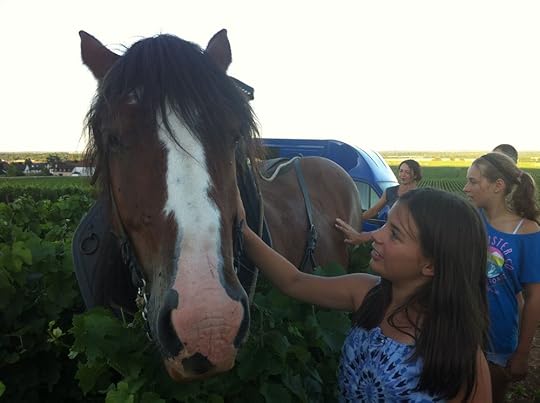
There is also the fact that vineyard horses bring back the tending of vineyards to a human scale. This is perfect for the small terroirs of Burgundy's valuable appellations. Horses, as you can see here, are much more satisfying to pat than a tractor.
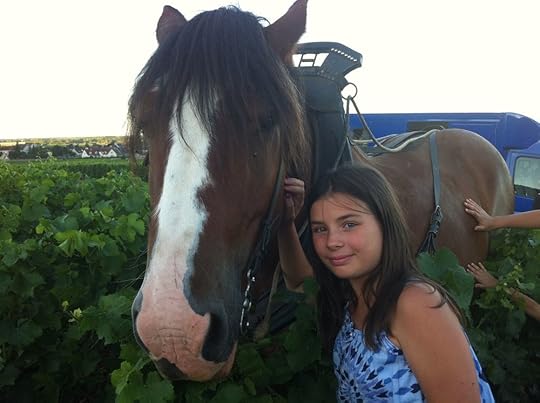
My girls fell in love with the horse whose name was Étoile (Star) and got in a good cuddle and chat with her until she had to head back and tend to a few more rows of Burgundy's precious vineyards before turning in for the night.
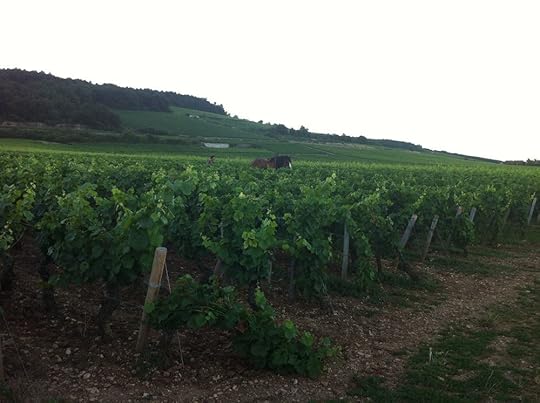
Have Amour for this?
Sign up with your email address to receive Laura's new blog posts and updates.
Email Address
Sign Up
We hate spam as much as you do.
Thank you!
January 22, 2017
Five Further French Habits to Adopt
Thanks to the popularity of my first two posts in this series, Five Life-Enhancing French Habits to Adopt Today and Three More French Habits to Enhance Your Life I've come up with some further things I was first exposed to during my many years living in France and which add pleasure, ease, and authenticity to our daily lives here at chez Germain, such as...
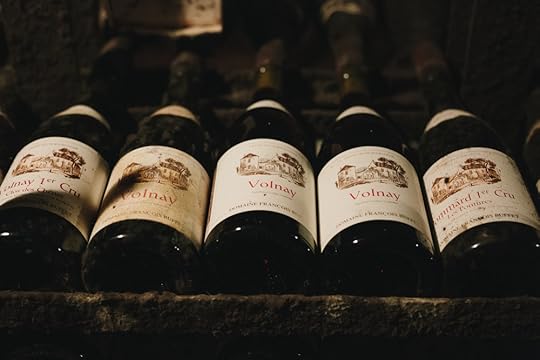
8. Put Down Some Wine
It is a stalwart tradition in Burgundy to "put down" bottles of wine in memory of special events, such as a child's birth, a baptism, graduating from high school, getting engaged, getting married, publishing a first book, running around the block in your underwear (or better yet, naked)...really, whatever rite of passage is important to a person and/or a family.
Franck and I were gifted amazing bottles of wine at our wedding in Burgundy - many from Franck's family and friends who were winemakers.
Generally wines given at a wedding ceremony are enjoyed at the births or baptisms (or both, we got A LOT of wine) of children and special wedding anniversaries. Bottles given to children on the occasion of their births are often opened when our "babies" turn eighteen or graduate from high school. Some are saved for their weddings as well.
This tradition can be adapted to any rites of passage that are important in a particular human journey. The important thing is that keepsake bottles of wine are meaningful, not to mention delicious, ways to celebrate the steps of life.
Make sure you purchase wine that will age well. Of course I recommend a good vintage of Burgundy pinot noir, but then again I may be slightly biased.
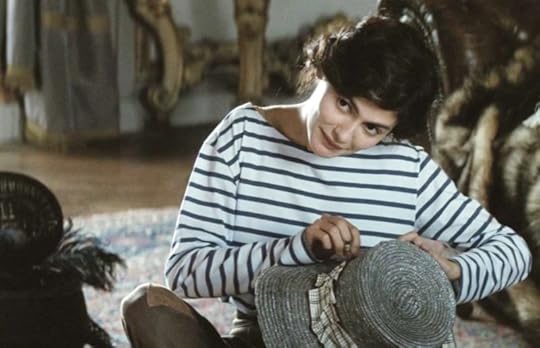
Audrey Tatou (who - funny story - is going out with the son of my ob/gyn in Beaune who delivered Clémentine and who I write about in my memoirs) showing off the effortless chic of the marinière in a still from the movie Coco Before Chanel.
9. Own a Marinière
Pretty much every French woman I know has a good-quality marinière in their closet. A marinière is the french name for the traditional white and blue striped top (though it now comes in a myriad of colors) which has been worn for centuries by french fishermen, especially the ones who hail from Brittany.
A good marinière should fit you comfortably and be a thick enough weave to keep you warm underneath your coat on a blustery day. They look effortlessly chic with jeans and flats or sandals, and equally good with a pair of rubber boots in the winter.
They are perfect for men, women, and look adorable on children of any age. In the summer on the french coast you will often spot whole families dressed in marinières.
My favourite brand of marinière is made by the wonderful french brand Amor-Lux which began in Quimper, Brittany. They are incredibly sturdy, soft, and their fit is pretty much parfait. They distribute all over the world, so you should be able to get your hands on one and inject some french style into your wardrobe no matter where you live.
10. Fight
In french households I have lived in family members fight - sometimes a lot. There is definitely a thing as too much or abusive fighting, but I'm talking about a periodic blow-up between equal partners.
Before living in France I probably repressed my urge to fight to my disadvantage. In my case, it manifested in anxiety and futile attempts to remove any source of conflict from my everyday interactions with others. That wasn't healthy for me as it turned out.
Now, when people ask me about our home life I say it is joyful but that it definitely includes fighting. As I write about in all my Grape memoirs Franck and I are not one of those couples who never say a cross word to each other. We both have fiery personalities and a stubborn streak a mile wide so clashes happen frequently. However, we always end up laughing about them afterwards.
We often reminisce about an epic fight we had in the chic restaurant Les TonTons on Beaune's Place Madeleine a couple of summers ago. I honestly can no longer remember exactly what we were fighting about, but we kept it up during five courses and terrorized the waiting staff. Now we are in stitches whenever we think about it. Sadly, though, it means we can never show our faces in Les TonsTons again despite the food being fantastic.
I love how for the french getting mad from time to time is just part of normal life - not the end of the world or something to be repressed at all costs. Like storm clouds fights blow over, blow past, and eventually leave us laughing.
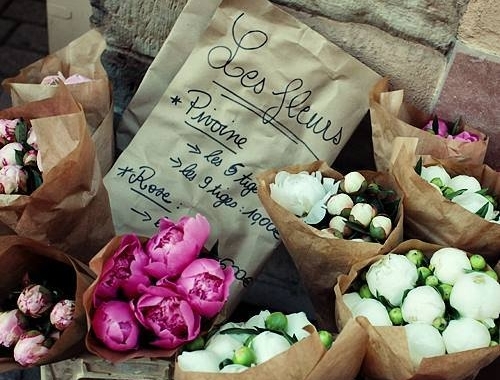
Pivoine (peony) season at the Saturday market in Beaune, Burgundy, France.
11. Bring Flowers
No french person I know would arrive as a dinner guest without bringing a lovely bouquet of flowers to the host.
Living in France makes this easy with gorgeous fleuristes everywhere and gobs of incredible seasonal flowers at the markets.
Here I like buying a little plant like a potted succulent or an orchid or something that has a chance of lasting a while. One of the best gifts I received recently from a friend is a potted aloe vera plant from the "babies" that have sprouted off her own aloe vera at home.
Living in Canada I have gotten lazy with this habit and I am determined to make an effort to start doing it again. Who, after all, doesn't find flowers brighten up their day?
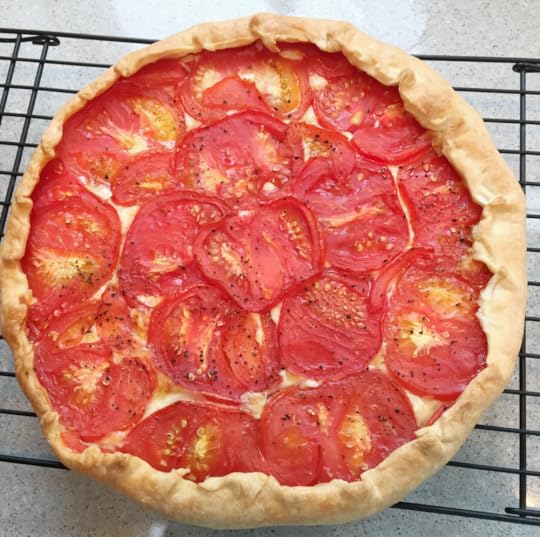
Our summer tomato tart made with Charlotte's homemade pastry recipe below.
12. Make Your Own Pastry
This last one is similar to my encouragement a few weeks ago to make your own vinaigrette. I had the idea of adding my pastry recipe to my "french habits" list because one of my favourite readers (who also happens to be a chef) asked for it - bonjour Erin! *waving* Also, aren't we all seeking practical ways to cook from scratch?
All my friends know that I am absolutely, without a doubt, the first person to take advantage of short-cuts on the domestic front. However, this recipe, bequeathed to me by my trés French, trés talented friend Charlotte Buffet ("Marie" in My Grape Village), is a pastry recipe so dead easy that even I make it often.
It takes about two minutes, never fails, and garners rave reviews every time.
To quote Charlotte directly, using this recipe for homemade Pâte Brisée when making any kind of quiches, fruit, or vegetable tarts “fait toute la différence.” It is the difference between a ho-hum tarte aux pommes and one that makes you want to kiss the person sitting next to you.
This recipe is what my French Habits posts are all about – emphasis on those little details that provide a heady effort / pleasure ratio.
Charlotte's Homemade Pâte Brisée Recipe
Ingredients
2 cups (250 grams) of flour
1 cup (125 grams) of unsalted butter
1/2 small glass (about 1/3 cup) of water
Pinch of salt
*Tools Required
Food processor with "S" blade attachment
Kitchen scale (metric) if measuring by weight
Instructions - Brace yourselves. This is really tough.
– Measure ingredients and add in no particular order into food processor.
– Press on “mix” button until ingredients have formed ball-like object which has detached from sides – takes about a minute or two.
– Remove pastry (voilà, you have just made pastry!) ball from food processor, flatten into disc, wrap in cellophane and put in fridge for at least an hour before using.
– 1/2 of the pastry ball is perfect amount for 6-8 person quiche or tart
*Lasts 3-4 days in the fridge and freezes wonderfully, so you can always have some pastry on hand.
** If you don't have a food processor you can do this in a Kitchen-Aid type mixer with the "K" mixing attachment OR in a humble bowl and mix together with clean hands until you can stick it all together in a ball.
Bon Appétit!
Have amour for this post?
Sign up with your email to receive blog posts and be entered to win a free week in the vineyards of Burgundy, France.
Email Address
Sign Up
We hate spam as much as you do.
Thank you!
January 12, 2017
10 Fave Things To Do in Paris
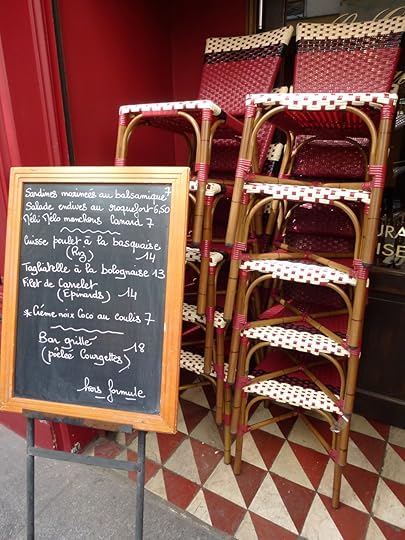
I have Paris on the brain. I am roughly half way through my first read-through and hand edit of My Grape Paris and every day I am immersed in memories of the year I attended la Sorbonne.
My Grape Paris will be the fifth book in my GRAPE series and will slot in between My Grape Year and My Grape Escape, during the year when Franck and I lived in the 5th arrondissement just behind Nôtre Dame and I studied medieval French Literature.
Revisiting that pivotal year as Parisiens made me want to share with you ten of our favourite things to do in the City of Light for when you next visit Paris (or better yet, live there for a while!):
1. Bateaux-Mouches at Night
Many people react to this suggestion with a guttural groan and think, Ugh. That's just for tourists.
Still, I challenge you to find a more magical experience than a bateau-mouche canal boat ride along the Seine after dusk has fallen. The lights of the city are lit and you are transported to the Paris that lives in our dreams - gliding past the huge clock on the Musée D'Orsay, sliding underneath the famous bridges, and turning around at the base of the glittering Eiffel Tower. We ride the bateaux-mouches at night almost every time we go to Paris. It never gets old.
We always use the Bateaux-Mouches de Pont-Neuf (found right beside Pont-Neuf bridge and actually called "Les Vedettes de Pont-Neuf"). Most of their boats are open to the sky on their second level. Go and sit up there for the best view. Here's the website: http://www.vedettesdupontneuf.com/
2. Late afternoon refreshments on the roof patio of l'Institute du Monde Arabe

This is the view you can enjoy with your authentic mint tea on the roof of l'Institut du Monde Arabe.
This gorgeous building and museum is right across the street from our old apartment in Paris. Not only is the complex worthy of devoting hours to in its own right, but you can eat a meal or just have a drink or tea on the elegant rooftop patio. It provides one of the best views of Paris, especially onto the Seine and the back of Notre-Dame. Here is the address: 1 rue des Fossées Saint-Bernard, Paris. www.imarabe.org/fr
3. Eat a Berthillon ice cream on the Île Saint Louis
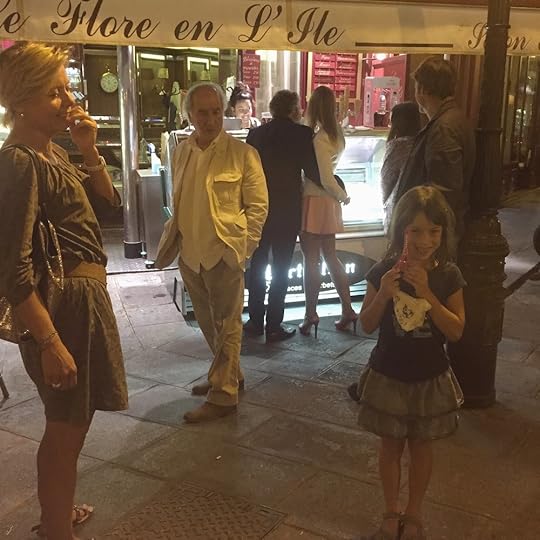
On our last trip to Paris we stopped by the Île Saint-Louis for Berthillon ice cream at midnight with our friend Joëlle (who had just bought Clem a pink Eiffel Tower embellished with rhinestones which Clem is proudly showing Franck behind the camera).
We never go to Paris - even in February - without stopping at least once on the Île Saint Louis and treating ourselves to a delicious cone of locally made Berthillon ice cream. You can find this ice cream for sale at storefronts all over the Île Saint-Louis (where it is made - can't get more local than that). Just make sure that is says the ice cream is "Berthillon" ice cream and not some knock-off version. Flavours are always changing but trust me, they are always delicious. http://www.berthillon.fr/
4. Picnic along the Seine
If you are planning an evening including the Bateaux-Mouches and Berthillon ice cream, you may as well plan a picnic on the Seine to round off your soirée. Pick any spot on the cobbled banks of the Île Saint-Louis or the Square Barye at the tip of the island which is usually a haven of bucolic greenery in the heart of Paris. Pick up baguettes, saucisson, cheese, fruit, and whatever else strikes your fancy from one of Paris' many markets, shops, or grocery stores. Also, don't forget a knife or two, glasses, and bien sûr, a bottle of wine.
5. Rue Mouffetard
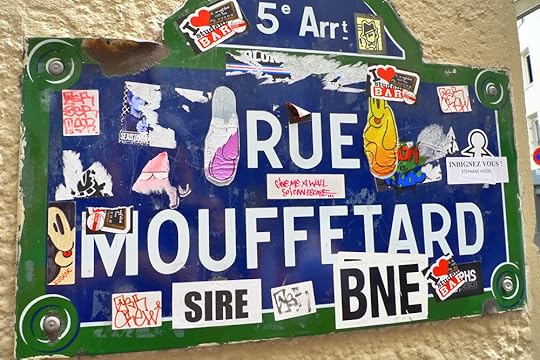
This medieval market street in the 5th arrondissment of Paris was in our old neighbourhood, and we went there several times a week. It is where Julia Child did her market shopping when she lived in Paris and an astounding number of famous people lived in and around this continually animated street. In A Moveable Feast (highly recommended reading before you visit Paris) Hemingway wrote about "that wonderful narrow crowded market street which led into the Place Contrescarpe" and lived only steps away.
The market stalls and shops which line the street are completely closed Sunday afternoon and all day Monday, but are open on the other days of the week. The most entertaining times are Saturday and Sunday morning when you really find the market in full swing. Not to be missed.
6. Arènes de Lutèce
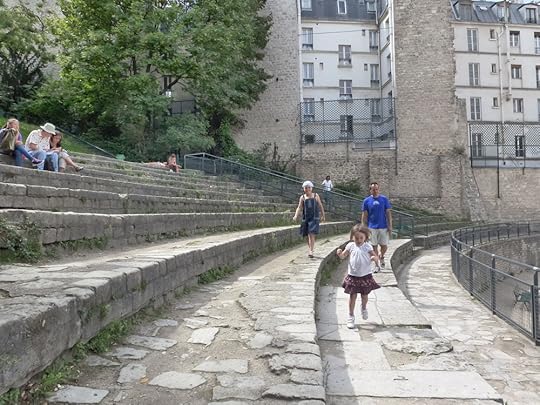
Clem, Franck, and Camille roaming around the steps where Romans used to lounge to watch gladiator fights.
Franck introduced me to this hidden treasure of Paris, which luckily for me happened to be located on my walk from our apartment on the rue des Fossées Saint-Bernard to my classes at the Sorbonne. Lutèce is the name for the Roman settlement that later evolved into Paris.
Just off the rue Monge, there is a heavy set of wood doors and if you push them open...voilà...you will discover an excavated and restored Roman amphitheatre from the Second Century AD. It was discovered when work was being done in the Monge neighbourhood in the late 19th Century. Victor Hugo was one of its first champions and argued for its restoration and preservation. Now it the Arènes de Lutèce is a city park, perfect for a picnic or watching the local men play a spirited game of pétanque.
The plaque by the door says, "It was here in the second century A.D. that the municipal life of Paris was born. Ten thousand men could keep comfortable in the arenas of Lutèce where jousting and gladiator combat was followed by wild animal fights, presentations of ancient comedies and dramas. When passing before this first monument of Paris, consider that the city of the past is also the city of the future and that of your hopes."
For me, the Arènes de Lutèce is hands down one of the most magical spots in Paris.
7. Eiffel Tower
This suggestion is hardly original, but to me I never wish to go to Paris and not pay an hommage - even a brief one - to the Eiffel Tower. The fact that it is visited by hundreds of thousands of people every year takes nothing away from its magic.
I don't need to go up it every time (but when we do, we always buy the less expensive tickets for the staircase to walk up to the second level - less of a line-up and a great way to compensate for our prodigious pastry consumption in Paris). After dusk its lights are turned on to "glitter" mode every hour on the hour for five minutes, so set your watches.
8. Musée Rodin
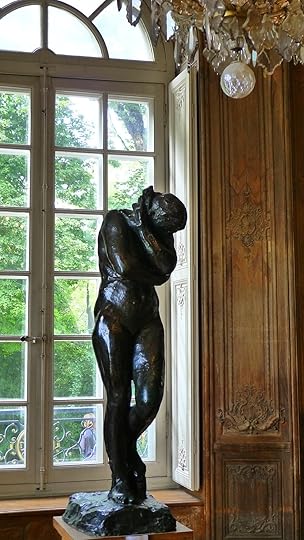
I love the Musée D'Orsay and the Louvre. In fact, the section of My Grape Paris I am editing right now is about the night Franck took me through all the back corridors and rooms of the Louvre when he was working there.
However, the Paris museum that probably holds the most appeal to me in the Rodin Museum. It is perfect in scale (not too overwhelming), not overly crowded, makes beautiful use of both indoor and outdoor space, and the sculptures are breathtaking to contemplate in person. http://www.musee-rodin.fr/en/museum/musee-rodin-paris/hotel-biron
There is also a new Rodin museum opened in 2015. It looks fabulous, although it is outside of central Paris is Meudon. I will be checking that out on my next visit. Here is its new website http://www.musee-rodin.fr/en/museum/musee-rodin-meudon
9. Shakespeare & Co.
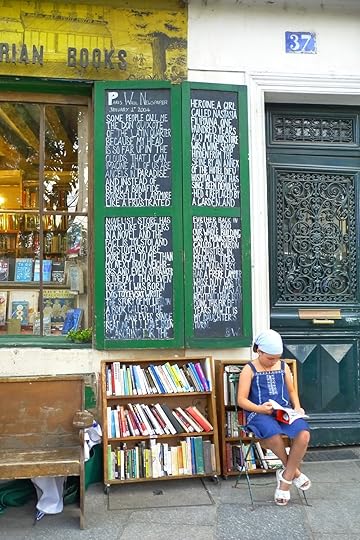
Camille checking out the books at Shakespeare & Co.
The iconic Shakespeare & co. bookstore has certainly become more touristy since Franck first took me there in 1991. However, for a book lover like me it is definitely on the "not-to-miss" list.
This spot in the 5th arrondissment (steps from Saint-Michel) is a left bank literary institution and was the center of literary life in Paris for such writers as Allen Ginsberg, William Burroughs, Anaïs Nin, Henry Miller, James Jones, and James Baldwin. It has also been home to the countless "tumbleweeds" - vagabond writers and intellectuals who slept in the beds wedged between the nooks and crannies of the stacks. Buy a book here and make sure it gets stamped inside with the beautiful store stamp.
10. People Watch in a Café
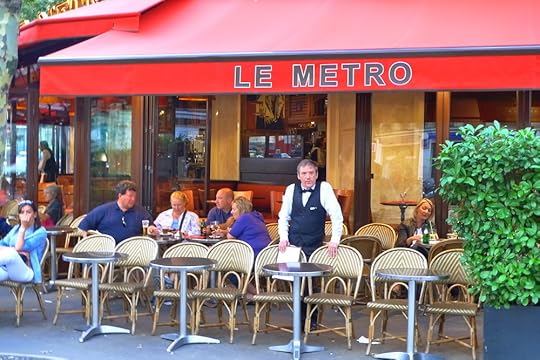
Paris is so full of things to do and experience that often we forget to do that most Parisian thing of all, wile away some time in a Parisian café, simply watching the world go by. There is no more authentic way to take part in the Parisien lifestyle.
Have "amour" for this post?
Sign up with your email address to receive future blog posts
Email Address
Sign Up
We hate spam as much as you do.
Thank you!
Follow
January 4, 2017
Chasing the January Blues - My Grape Year FREE from January 5-9th
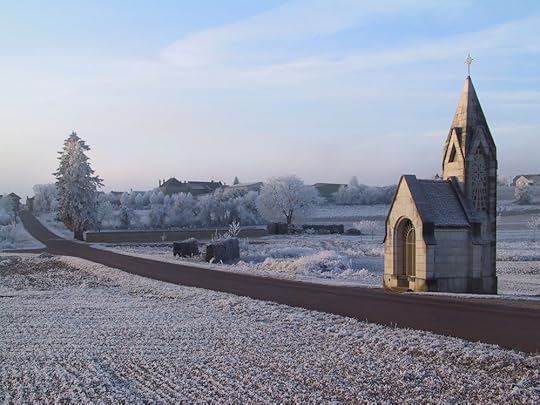
January can be rough. The excitement and cheese consumption of the holidays are (sadly) over. The Month of Reckoning has begun - our bank balances are depleted, our belts significantly tighter, and we discover yet again that New Years' Resolutions aren't nearly as much fun to keep as to make.
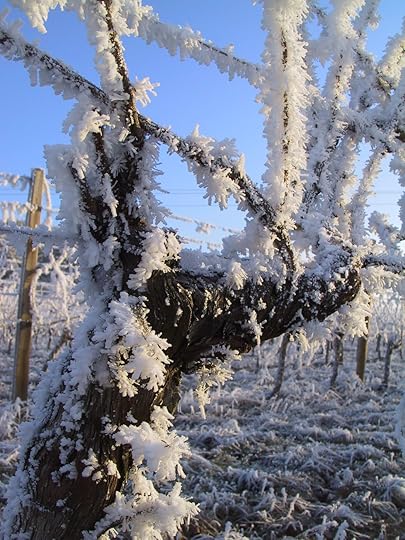
It's the same in Burgundy. January is a still month In Villers-la-Faye, when the vineyards are covered with frost and everything - including the people - seem to be sleeping, or perhaps digesting all that wine and cheese.
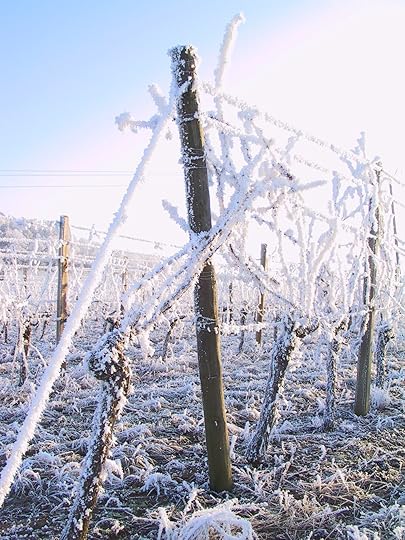
My personal antidote to the January blues is to curl up with a wonderful new book or, better yet, a wonderful new series of books.
I'd bet good money that many of my readers get through the winter months in a similar fashion, so starting January 5th (midnight) My Grape Year will be FREE until January 9th.
I've never offered any of my books for free before and don't plan to make a habit of it. This is a rare offering.

Just a reminder that if readers love My Grape Year (the first book in my GRAPE series), the recommended reading order for the series is as follows:
1) My Grape Year (free from Jan 5th - 9th)
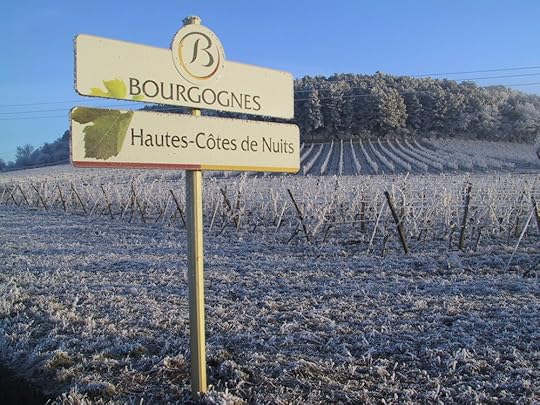
For all my lovely readers I hope this offer allows you to travel to France for a winter break with Franck, myself, and our Bevy in the vineyards of Burgundy.
Like this?
Sign up with your email address to receive weekly blog posts and enter to win a free week in Burgundy, France.
Email Address
Sign Up
We respect your privacy.
Thank you!
December 24, 2016
Joyeux Noël
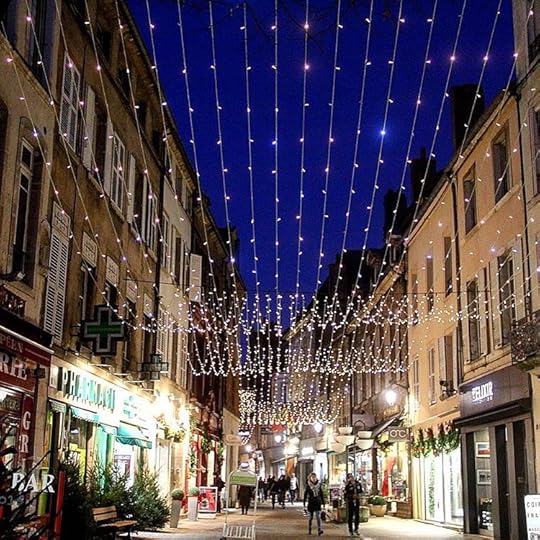
This lovely image was taken by Sue Boxell of @Burgundyonaplate .She runs wonderful wine and food tours in and around Beaune. www.burgundyonaplate.com
Wishing you all the merriest of Christmases, whether you find yourselves in Burgundy, or Africa, or Northern Canada. I hope you are surrounded by loved ones and joy. Here is an excerpt I wrote about a past Christmas in Burgundy (including plenty of food & wine porn) when we were knee deep in renovations at La Maison des Chaumes...Joyeux Noël!
***
The presents were quickly disposed of on Christmas morning. Charlotte and Camille ripped off the paper and squealed over their stuffy puppies and Polly Pockets. They ate a prodigious amount of papillottes and their enjoyment of the day didn’t seem to be at all affected by the torn wallpaper on the walls or the ugly floor tiles.
The tree and the decorations and the fact that the Père Noël came during the night, drank all the ratafia, and ate the papillottes made it a perfect Christmas in their eyes. A big Christmas was fun, but a modest Christmas had its rewards too.
Stéphanie, Franck's sister, told us to be at her house in Magny-les-Villers by 11:30 for the apéritif. She would not hear of me bringing anything to contribute to the Christmas meal. When I asked Franck why she was turning down repeated offers of help he said that it was her pride as a hostess to do everything herself. I wondered why I had never seemed to possess that particular brand of domestic pride.
Tom and Lola greeted us at the door, jumping up and down and telling us about the presents Père Noël had brought them. The most popular was Lola’s stand up microphone. The four cousins rushed upstairs to her bedroom try it out. By the time Thierry had poured us each a flute of mousseux the strains of loud, out-of-tune voices singing French pop songs floated down the stairs.
We were the last ones to arrive. There was Steph and Thierry, Thierry’s parents, his aunt from Dijon, Franck’s parents and of course La Mémé, equipped with several exquisite shawls to stave off drafts despite the roaring fire. We caught up with Thierry’s parents and his aunt while Stéphanie passed around homemade gougères – crunchy on the outside and rich and airy on the inside - made with Mémé’s recipe.
Eventually Steph went back in the kitchen and André went to help her. When I got up and offered to help I was shooed away and told to sit down at the table, stunningly decorated with tones of red and gold, and an abundance of freshly picked holly from the tree in the backyard.
Steph handed out the plates, beginning with Thierry’s aunt and Mémé and then moved on down the line in order of age. On each plate were two artfully arranged slices of foie gras, two slices of toasted brioche, and a scoop of fig jam.
Thierry busied himself with filling our glasses with a dark yellow Sauternes, perfectly chilled.
We waited until Steph and André were seated at the table and then Stephanie said “Bon alors, Joyeux Noël et bon appétit!” I scraped some foie gras on a piece of toasted, buttery brioche, topped it with fig jam, then washed it down with the beautifully paired Sauternes.
The foie gras was silky smooth of my tongue, enhanced by the sweet pops of the fig jam and the honeyed richness of the Sauternes. They mingled together to form a holy trinity of yum. The table fell silent for several minutes as everyone relished this first sublime bite of the holiday meal.
We talked about preparing the foie gras which Stephanie had done from scratch - well, not completely from scratch - she hadn’t force fed a goose but she had bought a freshly fattened goose liver and prepared, deveined, marinated and cooked it herself.
“Do you like it Laura?” she asked. I knew I should feel guilty about the force-fed goose, but the sheer deliciousness of the end product chased that from my mind.
“C’est délicieux,” I answered.
Why did few things back in Canada taste this satisfying? Why were flavors never quite so carefully and artfully matched? Here on my plate and in my glass was the perfect harmony of sweet and savoury. The buttery-ness of the brioche and the syrupy fig jam highlighted the silky unctuousness of the foie gras. Individually all these things were delicious, but married together they were sublime. Better yet, there was nothing else on the plate to distract any of us from the heavenly combination.
We took a good hour nibbling away at the first course. The children came down and they all ate a full plate just like the adults. All except Lola, that is, who was turning out - much to the despair of Franck’s family of gourmets - to be a picky eater. I wasn’t sure if my kids realized if they were eating fattened goose liver or, if they did, whether they would even care.
Without me realizing exactly when or how, their eating habits had improved drastically since we moved here. They sat down to eat three proper meals a day and a snack when they got home from school around five o’clock. There were still a few things they didn’t like, spinach for Charlotte and brussel sprouts for Camille, but they would try more or less anything else, mainly because the kids around them had to try everything too. The fact that most things they tried actually tasted good probably inspired them to be adventurous.
Charlotte and Camille proclaimed that the foie gras was delicious and declared it one of their new favourite foods, then asked if they could go upstairs to play. The cousins disappeared again, and Steph and Thierry and André took their time doing the dishes from the first course while Steph periodically checked the oven.
Finally she removed what had been in there and the house was filled with the smell of a roasted chapon - a rooster castrated at a young age – filled with a chestnut and pork stuffing.
Stephanie served this with a side of chestnuts for anyone who wanted them. I had grown up in Canada seeing chestnuts cover the sidewalk every autumn but I had never tasted them before or, indeed, ever seen anybody eat them. It was in France that I first realized how much I loved their earthy taste and texture.
Stéphanie served reduced jus from the roasted chapon as the sauce. Thierry, meanwhile, had taken out several bottles of Hospices de Beaune wine and served a Pommard premier cru.
He gave it to Franck to taste. Franck swirled it around in his glass, sniffed, and swashed it around his mouth and proclaimed it perfect. No one rushed on to anything else, and each plateful was just the perfect amount of flavours to savour without overwhelming the palate.
I thought back to our Christmas dinners in Canada. They were joyous affairs, but it was always such a race to get everything on the table at the same time; the turkey, the stuffing, the brussel sprouts, the scalloped potatoes, the green beans...Everybody filled their plates and rushed to the table to eat before it got cold (which it inevitably did). The flavours were good, but there were too many of them at once, and the whole thing was over far too fast.
The protracted nature and the small portions of meals in Burgundy forced everyone to slow down. Slowing down while eating, I realized now, was key to true appreciation and enjoyment of food and wine. There were no distractions apart from the flowing conversation.
After the chapon came a trou normande in the form of a lime sorbet with strong alcohol poured over it. This was, according to French belief, the secret to digesting well and making more room in our stomachs for the cheese and dessert courses.
The fromage platter was massive, and included a truly pungent and perfectly oozing “Ami de Chambertin, a half round of Cîteaux, and a crumbly and salty Cantal sheep’s cheese amongst other offerings.
Here too, the different textures and tastes of the cheeses riffed off each other creating an amazing taste experience. For the wine, Thierry served another Pommard from les Hospices that was groaning with ripe fruit flavours and structured tannins – absolutely the perfect foil to the cheeses.
Dessert came sometime after, along with a vin de paille from the Jura, a sweet intensely yellow wine that used half rotten grapes that had been aged on hay. Its richness complimented Mémé’s two “buches de Noël”, one mocha, one chocolate. Next came a praline kouglouf made by Franck’s father, served with the tiny china cups of strong espresso and bowls of papillottes and clémentine oranges.
As I was peeling my second orange the conversation ranged from wine to a debate about the best markets in the region.
Thierry’s father, nicknamed “Le Cadou” so insistently that I never knew his actual name, was a loyal attendee of the Friday morning market in Nuits-Saint-Georges where he went without fail to visit with friends and his favourite merchants and to buy whatever struck his fancy. Franck’s favourite market remained the Monday morning market in Louhans that featured veal’s brains and chilled white wine for the traditional pre-market breakfast. Mémé had always liked the market in the nearby town of Chagny. I argued for Beaune even though Franck’s family didn’t like the fact that it had seen an influx in tourists over the past decade during the summer months.
I glanced at my watch for the first time that day. “It’s ten o’clock at night!”
Indeed, darkness had fallen over the vineyards behind Steph and Thierry’s house long before, but somehow I didn’t have the impression of time passing. We had been at the table for almost twelve hours.
“A perfect Christmas Day,” Franck said, rubbing his stomach and reaching across the table to caress my palm.
December 12, 2016
Three More French Habits to Enhance Your Life
Due to the popularity of my recent post Five Life-Enhancing French Habits, I'm serving up three more ideas this week.
After what has been a rough year for many of us, I'm personally looking to infuse my life with gentleness, ritual, and pleasure whenever I can. Et toi?

Photo from noholita.fr via Pinterest
6) Embrace Scarves
Before my life in France, I thought of scarves as uniformly ugly and scratchy things that my mother forced upon me during the winter.
This all changed one day shortly after arriving in France. That morning I woke up in my bedroom in Nuits-Saint-Georges with a sore throat and a hoarse voice. Madame Beaupre, my first host mother, wouldn’t let me out the door to catch the school bus to Beaune without wrapping up my beleaguered throat in one of her many 100% silk Hermès scarves.
At first, I bore the scarf like I always had - with a definite air of martyrdom. Us hearty Canucks brooked no molly-coddling.
By the time the bus arrived in front of my school, however, I noticed the silk felt nice against my skin. As I was getting off the bus in Beaune I caught a glimpse of myself in the driver’s rear view mirror. I looked chic, I looked elegante, I looked French.
The sore throat did not turn into a cold. I had found a new miracle remedy; it was called Hermès.
My love affair with scarves continues to this day. At any given time my closet contains about fifteen of them. None are Hermés, but all of them keep my neck warm, add a certain je ne sais quoi to any outfit, and provide me with comfort and pleasure.
As for you men out there, I must confess that I have a bit of a thing for men in scarves.
Although some men, like my gynaecologist who I nicknamed Docteur Le Foulard in My Grape Village, favor the traditional men’s silk scarf, I prefer a heavier scarf tied simply. If any men out there are under the misconception that scarves are not masculine, please take a gander at Robert Doisneau’s celebrated photo below. I rest my case.
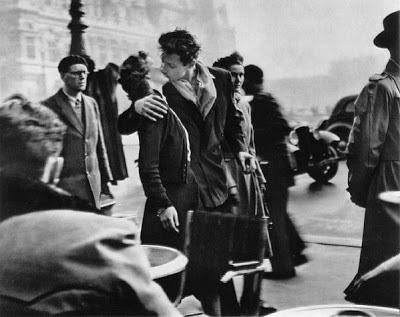
7) Nourish Your "Grain de Folie"
One common thread amongst all my closest friends is that they all carry a grain de folie somewhere in their personalities. A grain de folie means a bit of craziness, a tad of unreasonableness, and a certain capacity to suspend logic at unpredictable junctures.
On the surface, my friends often seem like incredibly sensible people. From time to time though, they strike out and do things such as move to London, start a jewelry-design business, consult with past-life spiritual advisors, design amazing city-wide food events, ditch the world and take off to Europe with only a backpack, become a tennis champion in middle age , etc. etc. I could literally go on for hours. They are a constant source of inspiration and entertainment.
The french have great respect for people with a grain de folie. My french friend Charlotte always says she's never that interested in people who don't have this quirk.
This perhaps explains why when Franck and I embarked on crazy endeavours such as renovating our restored winemaker's cottage we were - oui, bien sûr, met with disbelief, but also a certain grudging respect.
When I told people I was writing my first book My Grape Escape my french family and friends were fanatically enthusiastic. None of them wondered out loud if writing a book was a viable way to be spending my time, or if I thought a person could actually make money writing books (incidentally, yes one can, although the honest answer was that I had no idea way of knowing that before actually publishing it). The fact that my project was crazy was enough to satisfy them.
Crazy is marvellous. Crazy is anarchy (the French always love some quality anarchy). Crazy is LIVING.
Consider nourishing your own grain de folie and applauding it in the people around you. If nothing else, it makes life way more intriguing.
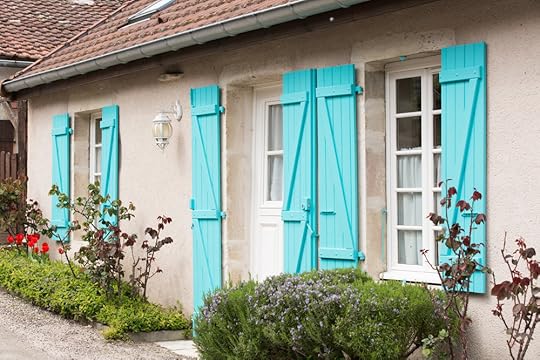
8) Enjoy an apéritif
One of my favorite parts of a traditional french meal, whether it be lunch or dinner, is the apéritif.
This initial ritual sets the stage for the hours to come and puts people in the correct frame of mind to socialize. It also, the French believe, "opens the appetite" for the deliciousness to come.
Similar to the beloved coffee break, the apéritif signals that it is time to slow down and just wallow in pleasure for the next few hours. The french tend to be extremely proficient at ritualizing these "gear shifting" moments. I try to integrate them into my daily life whenever I can.
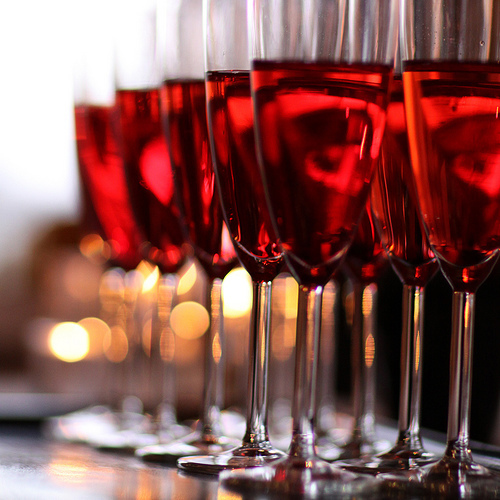
Just in case you’ve forgotten how to make a kir – THE most Burgundian of apéritifs and one that is *ahem* mentioned rather frequently in all four of my books - here’s the Germain family recipe…
Burgundian Kir:
1/3 Crème de Cassis (blackcurrant) liquor – Vedrenne is a very good brand, and in the Hautes-Côtes around our vacation rentals check out the local producers such as the Ferme Fruirouge in Concoeur itself and the Jouannet family in Meuilley
+
2/3 Bourgogne Aligoté – We *heart* the aligoté from Domaine Naudin-Ferrand in Magny but in a pinch any dry white wine can suffice (but not really, DO try to find an aligoté - it's worth the effort)
Step #1: Pour the cassis and then the aligoté into a short wine glass (NEVER pour in the wine first, then add the cassis, or for the-love-of-God ever attempt to stir it at any point).
Step #2: Sip
Step #3: Contemplate the wisdom of the following quote from Victor Hugo, “God made only water, but man made wine.”
November 29, 2016
Brocante tour of La Maison de La Vieille Vigne
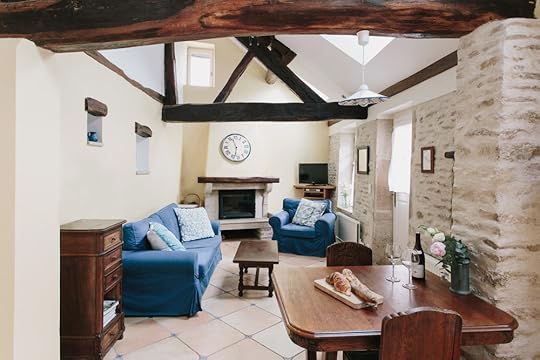
Following my recent blog post about the antiques we found to furnish La Maison des Chaumes (our other vacation rental in Villers-la-Faye) here is a peek at our finds at La Maison de la Vieille Vigne - our 16th Century restored winemaker's cottage just steps from the Burgundian vineyards.
The most compelling ancient item in La Maison de la Vieille Vigne is actually the original structure of the cottage itself. It dates back to the mid 1600s and I fell in love with its exposed oak beams, rock walls, and the massive, gnarled grape vine that had been growing around the outside of the house for as long as anyone in Villers-la-Faye could remember.
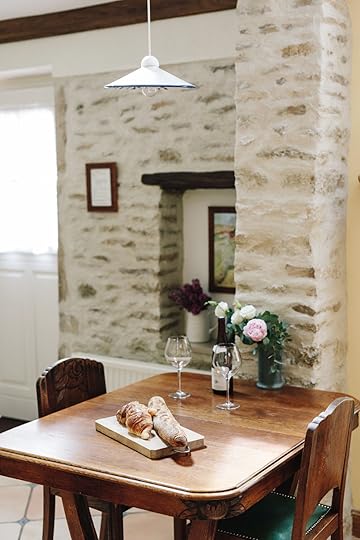
This was pre-renovation so of course pretty much everything else was a complete disaster - the bathroom was a pestilent chicken coop, there was a rusty furnace with a nasty habit of disgorging noxious black smoke in the middle of the bedroom, and many other "surprises" many of you read about in My Grape Village. Yet all I saw was the oak beams, stone walls and the original stone fireplace. I figured, with my trademark deranged optimism, we could fix the rest. Quelle blague, as the French would say.
The process was not quite as easy as I had imagined. In fact, it was like a year long French / Burgundian version of "Trading Spaces". Yet, we somehow managed to pull it off mere hours before our first guests arrived.
In the end, the cottage needed little adornment. I picked up this sturdy table and chairs that date back to the 1930s / 1940s at our favorite brocante in Dijon. They glow with the earned patina of decades in another french kitchen before they came to us.
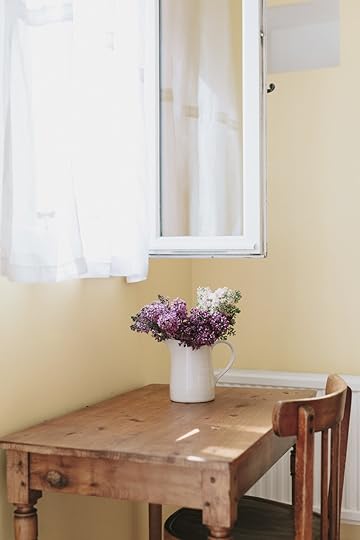
As a writer, it is essential to me to equip each of our four vacation rentals with a simple but inspiring writing desk. I realize that most of our guests probably use the desk for other work (or not at all, which is also a totally legitimate thing in France). However, I eternally nourish the dream of writing in beautiful, inspiring places so I search high and low for THE perfect writing desk and chair.
We picked this one out at a local vide-grenier in the streets of the village of Premeaux-Prissey. We were so late that we arrived when everyone was packing up, a disappointment at first but in the end fortuitous. We snagged the perfect desk and chair for the cottage for a steal because the guy did not want to pack it back into his van.
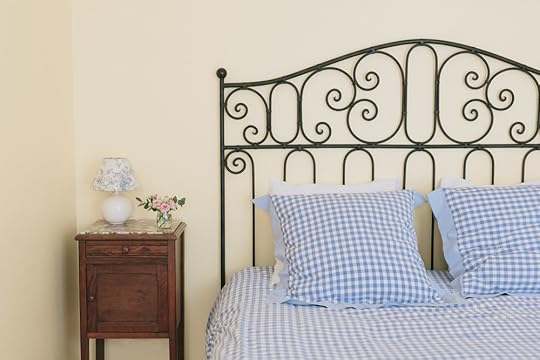
I picked up the bedside tables - charmingly mismatched - at a street brocante in Chagny. I love the french style of bedside table with marble tops. Why don't they do them like that anymore? Beautiful and practical.
I love the antique hunting so much in France that it is seriously what would make me buy five more houses there - but there are limits even to my deranged optimism.
Enjoy this post?
Sign up here to receive them direct to your in-box and also be automatically entered to win a free stay in Burgundy, France.
Email Address
Sign Up
We respect your privacy.
Thank you!
Follow my blog with Bloglovin
Brocante Tour of La Maison de la Vieille Vigne

Following my recent blog post about the antiques we found to furnish La Maison des Chaumes (our other vacation rental in Villers-la-Faye) here is a peek at our finds at La Maison de la Vieille Vigne - our 16th Century restored winemaker's cottage just steps from the Burgundian vineyards.
The most compelling ancient item in La Maison de la Vieille Vigne is actually the original structure of the cottage itself. It dates back to the mid 1600s and I fell in love with its exposed oak beams, rock walls, and the massive, gnarled grape vine that had been growing around the outside of the house for as long as anyone in Villers-la-Faye could remember.

This was pre-renovation so of course pretty much everything else was a complete disaster - the bathroom was a pestilent chicken coop, there was a rusty furnace with a nasty habit of disgorging noxious black smoke in the middle of the bedroom, and many other "surprises" many of you read about in My Grape Village. Yet all I saw was the oak beams, stone walls and the original stone fireplace. I figured, with my trademark deranged optimism, we could fix the rest. Quelle blague, as the French would say.
The process was not quite as easy as I had imagined. In fact, it was like a year long French / Burgundian version of "Trading Spaces". Yet, we somehow managed to pull it off mere hours before our first guests arrived.
In the end, the cottage needed little adornment. I picked up this sturdy table and chairs that date back to the 1930s / 1940s at our favorite brocante in Dijon. They glow with the earned patina of decades in another french kitchen before they came to us.

As a writer, it is essential to me to equip each of our four vacation rentals with a simple but inspiring writing desk. I realize that most of our guests probably use the desk for other work (or not at all, which is also a totally legitimate thing in France). However, I eternally nourish the dream of writing in beautiful, inspiring places so I search high and low for THE perfect writing desk and chair.
We picked this one out at a local vide-grenier in the streets of the village of Premeaux-Prissey. We were so late that we arrived when everyone was packing up, a disappointment at first but in the end fortuitous. We snagged the perfect desk and chair for the cottage for a steal because the guy did not want to pack it back into his van.

I picked up the bedside tables - charmingly mismatched - at a street brocante in Chagny. I love the french style of bedside table with marble tops. Why don't they do them like that anymore? Beautiful and practical.
I love the antique hunting so much in France that it is seriously what would make me buy five more houses there - but there are limits even to my deranged optimism.
Enjoy this post?
Sign up here to receive them direct to your in-box and also be automatically entered to win a free stay in Burgundy, France.
Email Address
Sign Up
We respect your privacy.
Thank you!
Follow my blog with Bloglovin
Bonjour, World!
November 21, 2016
Five Life-Enhancing French Habits
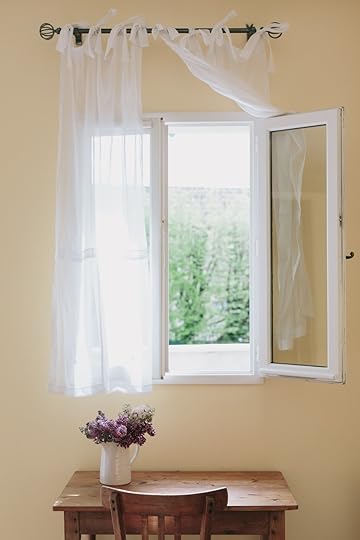
There are habits I developed while living in France that I carry with me no matter where I travel in my life. Keeping these takes me zero effort. They are all small things - les petites choses - that, when practiced daily, somehow make my life infinitely better.
Here are five of the life-enhancing french habits I have adopted:
1) Open up my windows to airé, or air out, my house for a few minutes every morning
Granted, this habit is even more satisfying when you have a real pair of french shutters to fling open, but even without them opening your windows to let the morning air in your house just feels good. In the summer I leave the windows open for an hour or more, in the winter just five minutes. No matter what length of time I open up for though, the fresh air helps us all feel more alert and alive.
The French are also convinced that this habit helps reduce the spread of viruses and other air-born nasties. Regardless, it is completely free and the ritual and fresh air never fail to make me feel better.
2) Answer honestly when people ask how you're doing
I got my first taste of this in Beaune, when I ventured to ask a fellow mother ça va? at school drop-off one morning.
"Holy Christ," she answered. "I'm ready to murder my husband and in the backseat of the car my kids were punching each other again about Pokemon cards. I swear to god I almost stopped at that gypsy camp near the autoroute to see if the gypsies might be interested in buying them - my offspring, not the Pokemon cards, I mean. Now I have to go to the ob/gyn for my pap smear. Just kill me and get it over with."
My first instinct was to run in the opposite direction, but then I got in the spirit of things and confided how Camille had thrown up all over the backseat of the car on the way to school the day before. We went back and forth like this and five minutes later I began the day refreshed by an edifying venting session.
I learned that when you ask "ça va?" to a French person, you have to brace yourself for an honest answer. Some days they are doing great and they will tell you why, in detail. Some days they are wretched and they will tell you why, in detail. They expect you to be just as honest.
I found that it is so much less exhausting to jettison the façade of everything being "just great" all the time. I also learned from my fellow French moms that on a bad day sometimes a good vent is all that is required to turn it into a good one.
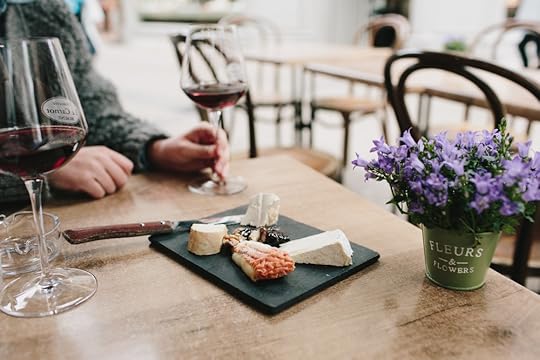
3) Eat a bit of raw, unpasturised cheese every day
You know all those studies that try to figure out the "french paradox", or why french people can live to ripe, healthy old ages despite a diet that is heavy in cream, butter, and carbohydrates? The consumption of good-quality wine (i.e. not Two Buck Chuck) certainly seems to be part of this riddle, but more and more studies are pointing to something else too - the variety of raw, artisan cheese the French consume.
I have never taken much convincing to taste even the stinkiest, mouldiest French cheese. Imagine how delighted I was to find that this raw cheese habit of mine may be contributing to healthy gut mircobiota, better immunity, not to mention extreme gustative satisfaction and pleasure.
There are more and more artisan cheeses available all over the world, both imported and made locally. Be like the french - invest a little extra time and money to make your cheese habit a truly beneficial one.
4) Kiss (or hug) your family every morning and every night
Anyone who has stayed in France can tell you that greeting family members the first time you see each other in the in the morning and saying good-night to them as you go to bed is an unassailable daily ritual.
It is not merely the words "bonjour" and "bonne nuit - dors bien", but the act of giving and receiving les bises, or a kiss on each cheek, that cements the greeting.
When we first came back to Canada after five years in France I found we were swept up into such a quickly paced life that we let this ritual fall by the wayside until one day it dawned on me how much I missed this brief but important moment of family connection.
Camille was laughing yesterday about how La Mémé (Franck's grandmother who is a main character in all my books) was such a stickler about everyone in the family - even the young children - saying "bonjour" and "au revoir" properly with les bises. She would withhold a snack from the non-compliant great-grandchildren (*ahem* meaning Camille) until the lure of La Mémé's pastries overcame Camille's stubborn refusal about giving her great-grandmother a kiss on the cheek.
Us humans need contact to ground and reassure ourselves, so the hello / good-bye ritual benefits everyone in a family - parents and children alike. It also prevents us from passing by each other like ships in the night day after day. It is a moment to pause and communicate to our loved ones -I see you. I appreciate you. I love you.
5) Make your own vinaigrette
I have not bought bottled salad dressing since my first year in France when my lovely first host mother, Madame Beaupre, taught me how to make her delicious vinaigrette. It is so quick and easy and only requires three ingredients:
Madame Beaupre's Vinaigrette
1 TBSP mustard (Dijon or grainy Dijon my favourite) + 1 tsp vinegar + 2-3 TBSP oil
Put mustard of your choice (but stay away from hot dog-type mustard) into bottom of salad bowl. Add vinegar of your choice (any kind of wine or balsamic vinegar, apple cider vinegar, or anything else that takes your fancy) and stir into mustard with fork until blended. Add oil (olive oil, canola oil, or any other type of oil you like) and stir in vigorously with fork until blended.
Optional: You can add to this basic mix freshly ground pepper, a pinch of fleur de sel, diced shallots, diced or pressed garlic clove(s), herbs - fresh or dried - or really anything that appeals to you.
Voilà! Now you too can dispense with store-bought vinaigrette and like any french person worth their salt serve delicious salads at the drop of a hat. Bon Appetit!

Love this post?
Have new posts sent directly to your inbox.
Email Address
Sign Up
We respect your privacy.
Thank you!
November 13, 2016
French Shutters
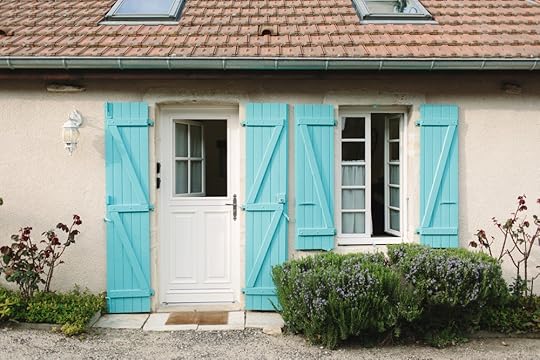
One of the things I love most about our slower days in France is the routine of opening up the shutters at La Maison des Chaumes in the morning and shutting them again in the evening.
It gives me a chance to welcome the new day in the morning and to open the windows to fill the house up with crisp, fresh morning air.
In the evening, closing and locking the shutters refocuses my attention inwards towards my family and our beds. There is nothing like closed shutters that make me feel all snug with Franck and our baby chicks inside our Burgundian nest.
When our french family and friends come to visit us in Canada they are astounded at how the houses in North America have no shutters. "Don't you feel unsafe?" they ask. "Don't you feel exposed?"
I don't, really, because I grew up without shutters. However, I do suspect this makes me more appreciative of them than the average french person.
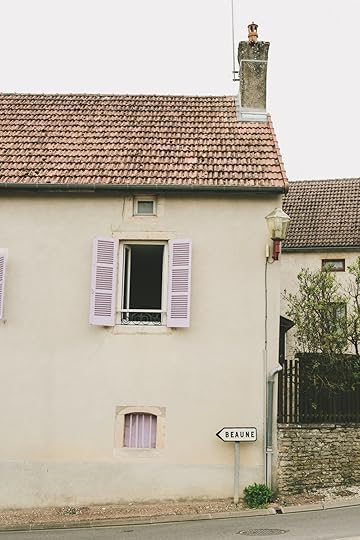
Then there is the highly controversial (in the villages of Magny-les-Villers and Villers-la-Faye anyway) matter of color.
Shutters are pretty much one of the most fun things to paint when renovating a house in France. For La Maison de la Vieille Vigne I was delighted to pick a shade of turquoise that Franck's grandmother, La Mémé, called "Le Bleu de Villers" or "Villers Blue." She called it this because many decades ago, before more conservative colors became the fashion, the shutters of her house (now Franck's parents' house) and many other houses in the village were exactly the same blue.
For La Maison des Deux Clochers, my choice of shutter color has always been a little bit - shall we say - controversial. It has been a subject of much consternation and debate in the village of Magny-les-Villers.
Part of this, of course, is because the house is in the center of the village (right across the street from the church). The current lilac color caused as much gossip as its previous iteration of cornflower blue.
Next time the task of shutter-painting comes around (about once every 7-10 years) I think I might go with something even bolder so as not to let down my fellow villagers.
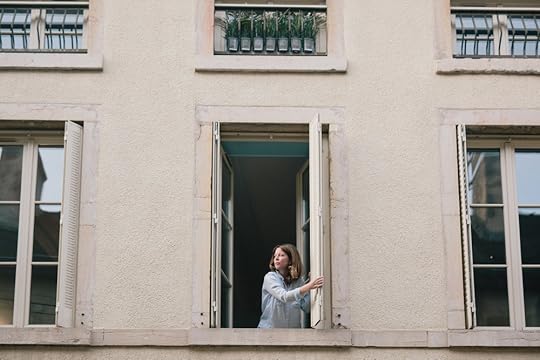
The huge windows in our Beaune apartment have to be painted a very specific shade of cream, thanks to the dictates of the tyrannical Architect of French Monuments (who we memorably clashed with when renovating La Maison de la Vieille Vigne in My Grape Village).
This man is so universally reviled that I have a hard time believing he hasn't been a murder victim yet. I once heard an acquaintance comment, "If he ever crosses the road in front of my car at night, I won't be hitting the breaks - that's certain."
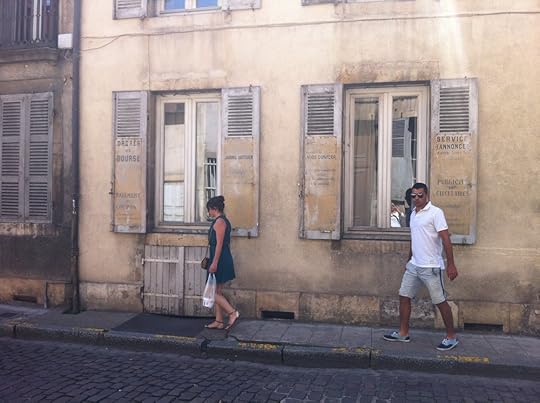
One of my favourite sets of shutters in Beaune are these ones, just on the rue des Tonneliers - the street parallel to Le Relais du Vieux Beaune. They were used many decades ago as advertising boards for the shopfront within, and have been left there to age gracefully.
I usually pause to admire them when I pass by on the way to the market or the Brasserie le Carnot. Aren't those old fonts amazing?
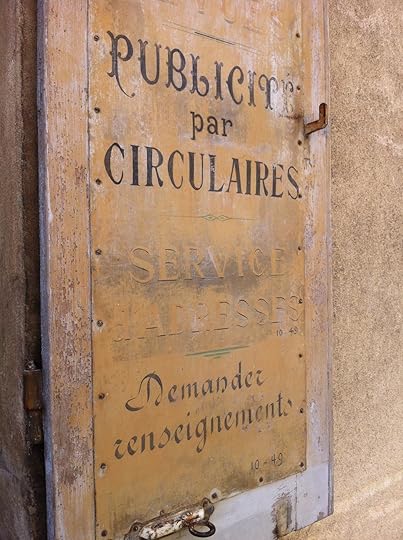
I have such a love for shutters in France that I have created a Pinterest board that is entitled with an utter lack of imagination as "Shutters of France". The title needs no imagination though, as the shutters themselves posses more than enough escapism and whimsy all on their own.



